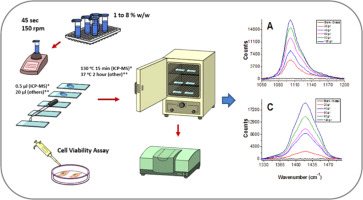Talanta ( IF 5.6 ) Pub Date : 2017-08-01 , DOI: 10.1016/j.talanta.2017.07.092 M. Sadi Gurses , Can Erkey , Seda Kizilel , Alper Uzun

|
Sodium tripolyphosphate (STPP) and sodium citrate dihydrate (sodium citrate) are the most widely used components in detergent formulations. Here, we characterized these two components on glass surfaces to assess their possible exposures from white spots on dishwasher-washed dishes. Ultraviolet/visible near infrared spectroscopy (UV/Vis-NIR), Fourier transform infrared spectroscopy (FTIR) in the attenuated total reflectance mode (ATR-FTIR), Raman spectroscopy and laser ablation-inductively coupled plasma mass spectroscopy (LA-ICP-MS) were utilized to design calibration models for a range of STPP and sodium citrate concentrations 1–8% w/w) precipitated on glass surfaces. STPP and sodium citrate residues on the dishwasher-washed dishes were also determined quantitatively using ATR-FTIR by utilizing these calibration models. In addition, cytotoxicity assays were performed to elucidate the influence of STPP and sodium citrate on human embryonic kidney cell survival. Cell viability results showed a decreasing trend in the number of cells cultured with increasing concentrations and exposure time of STPP and sodium citrate in the medium. Cell survival was minimum on day four when cells were exposed to 84 mg/kg of body/day of STPP and sodium citrate separately. This is the first report about detection and quantification of STTP and sodium citrate and assessment of cytotoxicity. Results of this study provide opportunities for the quantification of detergent residues on dishes and assessment of their possible toxicity on live cells.
中文翻译:

表面上三聚磷酸钠和柠檬酸钠脱水残留物的表征
三聚磷酸钠(STPP)和柠檬酸钠二水合物(柠檬酸钠)是洗涤剂配方中使用最广泛的组分。在这里,我们对玻璃表面上的这两个成分进行了表征,以评估它们在洗碗机洗涤过的餐具上白斑的可能暴露。紫外线/可见光近红外光谱(UV / Vis-NIR),傅里叶变换红外光谱(FTIR),全反射衰减模式(ATR-FTIR),拉曼光谱和激光烧蚀-电感耦合等离子体质谱(LA-ICP-MS )被用来设计校准模型,用于一系列沉淀在玻璃表面上的STPP和浓度为1–8%w / w的柠檬酸钠。通过使用这些校准模型,还可以使用ATR-FTIR定量测定洗碗碟机洗碗后的STPP和柠檬酸钠残留量。此外,进行了细胞毒性试验,以阐明STPP和柠檬酸钠对人胚胎肾细胞存活的影响。细胞活力结果显示,随着培养基中STPP和柠檬酸钠浓度和暴露时间的增加,培养的细胞数量呈下降趋势。当细胞分别暴露于84 mg / kg身体/天的STPP和柠檬酸钠时,第四天的细胞存活率最低。这是关于STTP和柠檬酸钠的检测和定量以及细胞毒性评估的第一份报告。这项研究的结果为量化餐具上的洗涤剂残留以及评估其对活细胞的毒性提供了机会。细胞活力结果显示,随着培养基中STPP和柠檬酸钠浓度和暴露时间的增加,培养的细胞数量呈下降趋势。当细胞分别暴露于84 mg / kg身体/天的STPP和柠檬酸钠时,第四天的细胞存活率最低。这是关于STTP和柠檬酸钠的检测和定量以及细胞毒性评估的第一份报告。这项研究的结果为量化餐具上的洗涤剂残留以及评估其对活细胞的毒性提供了机会。细胞活力结果显示,随着培养基中STPP和柠檬酸钠浓度和暴露时间的增加,培养的细胞数量呈下降趋势。当细胞分别暴露于84 mg / kg身体/天的STPP和柠檬酸钠时,第四天的细胞存活率最低。这是关于STTP和柠檬酸钠的检测和定量以及细胞毒性评估的第一份报告。这项研究的结果为量化餐具上残留的洗涤剂以及评估其对活细胞的毒性提供了机会。这是关于STTP和柠檬酸钠的检测和定量以及细胞毒性评估的第一份报告。这项研究的结果为量化餐具上残留的洗涤剂以及评估其对活细胞的毒性提供了机会。这是关于STTP和柠檬酸钠的检测和定量以及细胞毒性评估的第一份报告。这项研究的结果为量化餐具上的洗涤剂残留以及评估其对活细胞的毒性提供了机会。











































 京公网安备 11010802027423号
京公网安备 11010802027423号